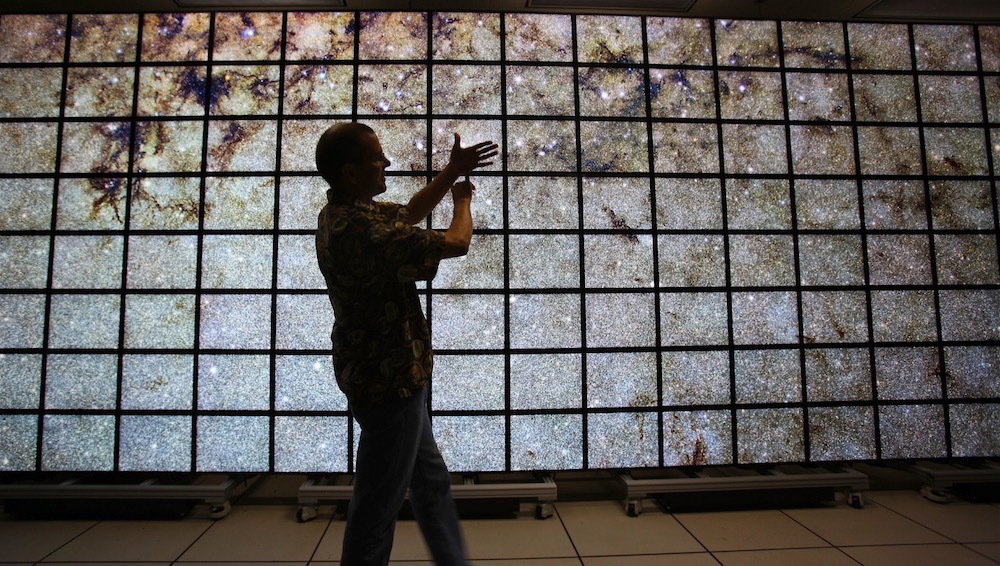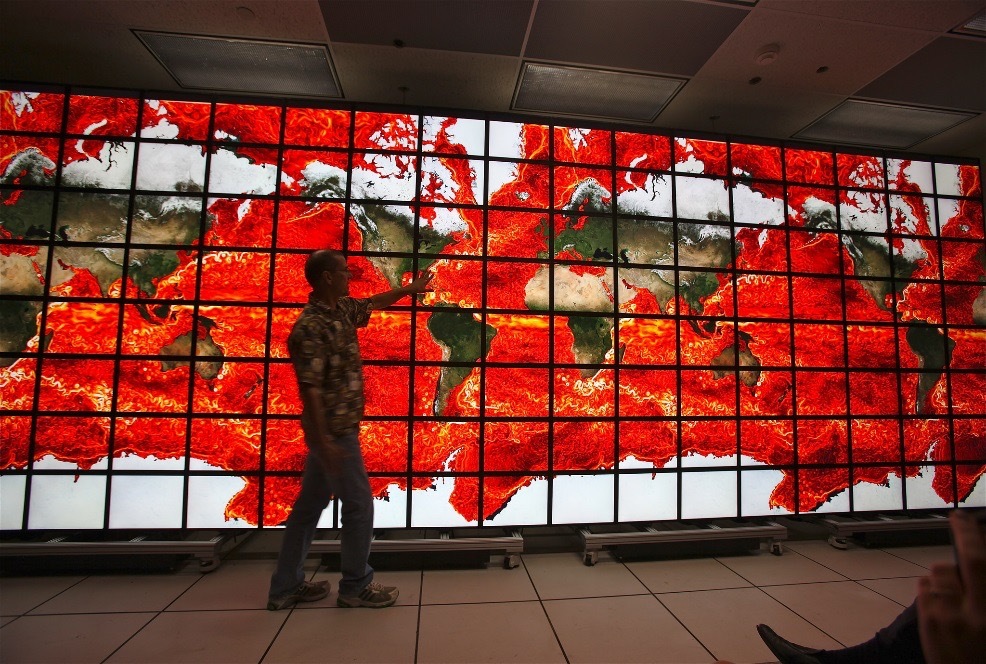NASA's Hyperwall System Now Uses Storage System vFlash
NASA's Hyperwall is a video wall consisting of a huge array of monitors and capable of displaying multiple images in high quality at the same time. This installation is necessary for the agency to visualize the phenomena, ideas and changes occurring in the world and related to astrophysics, heliophysics and planetary science. For this, data obtained by NASA from telescopes and satellites are used.
NASA's computing farm is located at the Ames Research Center. They are working on the HECC project, which allows scientists and engineers to carry out simulations, simulations and analytical work on a large scale to calculate all the missions of the Space Agency.

/ Flickr / steve jurvetson / cc
')
Hyperwall was developed as part of this project. The wall consists of 16 columns and 8 rows of monitors to display the results of simulations. One example of such a simulation can be the project “The scheme of currents and climatic features of the ocean” (Estimating the Circulation of the Ocean), which aims to provide a visual model of the world ocean.
Similar models (examples of which can be found by reference ) include huge arrays of multidimensional data generated by NASA supercomputers. Therefore, engineers faced a nontrivial task of providing parallel access to data for all 128 computing nodes that process information with an indefinite number of random input and output parameters. A virtual storage system based on NVMe drives was used as a solution.
The NVMe interface is designed to maximize the benefits of solid-state drives that have low latency and allow pipelined read and write operations. NVMe contains a number of improvements aimed at reducing parasitic delays when working with data compared to the SATA interface and the AHCI protocol.
It should be noted that NVM technology has gained a certain popularity in the market. And at once several companies are planning to set up (or set up) the release of NVMe class drives for the consumer market. Toshiba and Plextor have already released their decision to the masses, and the product from Western Digital will be released in early 2017.
The new WD Black will be implemented in the M.2 NVMe format, which implies the use of four PCI Express 3.0 lanes with an aggregate bandwidth of 32 Gbps. The characteristics of the new WD are unknown, but if the assumption about the controller used is confirmed, they should be expected to have speeds similar to those shown by products from other companies, namely Toshiba OCZ RD400 and Plextor M8Pe.
In developing the system, NASA engineers first placed a 2 TB flash drive on each compute node. Then the programmers broke the data into blocks of 2 TB and copied it to each disk. However, they then faced certain difficulties: further processing had to take into account the location of the data during the calculations, which complicated the programming process. The solution to this problem was the NVMesh technology.

/ Flickr / steve jurvetson / cc
All 128 2TD drives were aggregated into a pool — a virtual storage system with a capacity of 256 TB, accessed via RDMA. In this case, each flash drive as it remained local for each node, but it simplified the procedure for parallel access to them.
This approach added 5 µs of delay (mainly due to the network) as compared to local deployment, but eliminated the difficulties associated with programming the solution. According to the tests, the bandwidth of the system was about 140 GB / s. This approach allowed scientists and engineers to perform faster and “smooth” simulations, increasing the productivity of the research.
Other materials from the blog IT GRAD on Habré:
NASA's computing farm is located at the Ames Research Center. They are working on the HECC project, which allows scientists and engineers to carry out simulations, simulations and analytical work on a large scale to calculate all the missions of the Space Agency.

/ Flickr / steve jurvetson / cc
')
Hyperwall was developed as part of this project. The wall consists of 16 columns and 8 rows of monitors to display the results of simulations. One example of such a simulation can be the project “The scheme of currents and climatic features of the ocean” (Estimating the Circulation of the Ocean), which aims to provide a visual model of the world ocean.
Similar models (examples of which can be found by reference ) include huge arrays of multidimensional data generated by NASA supercomputers. Therefore, engineers faced a nontrivial task of providing parallel access to data for all 128 computing nodes that process information with an indefinite number of random input and output parameters. A virtual storage system based on NVMe drives was used as a solution.
The NVMe interface is designed to maximize the benefits of solid-state drives that have low latency and allow pipelined read and write operations. NVMe contains a number of improvements aimed at reducing parasitic delays when working with data compared to the SATA interface and the AHCI protocol.
It should be noted that NVM technology has gained a certain popularity in the market. And at once several companies are planning to set up (or set up) the release of NVMe class drives for the consumer market. Toshiba and Plextor have already released their decision to the masses, and the product from Western Digital will be released in early 2017.
The new WD Black will be implemented in the M.2 NVMe format, which implies the use of four PCI Express 3.0 lanes with an aggregate bandwidth of 32 Gbps. The characteristics of the new WD are unknown, but if the assumption about the controller used is confirmed, they should be expected to have speeds similar to those shown by products from other companies, namely Toshiba OCZ RD400 and Plextor M8Pe.
In developing the system, NASA engineers first placed a 2 TB flash drive on each compute node. Then the programmers broke the data into blocks of 2 TB and copied it to each disk. However, they then faced certain difficulties: further processing had to take into account the location of the data during the calculations, which complicated the programming process. The solution to this problem was the NVMesh technology.

/ Flickr / steve jurvetson / cc
All 128 2TD drives were aggregated into a pool — a virtual storage system with a capacity of 256 TB, accessed via RDMA. In this case, each flash drive as it remained local for each node, but it simplified the procedure for parallel access to them.
This approach added 5 µs of delay (mainly due to the network) as compared to local deployment, but eliminated the difficulties associated with programming the solution. According to the tests, the bandwidth of the system was about 140 GB / s. This approach allowed scientists and engineers to perform faster and “smooth” simulations, increasing the productivity of the research.
Other materials from the blog IT GRAD on Habré:
- Questions and answers about communications and technology in space ( part 1 and part 2 )
- How cloud technologies change the world of sports
- IaaS Digest: Introducing Virtual Infrastructure
- “What is the benefit?”: Feasibility study of using IaaS
Source: https://habr.com/ru/post/316284/
All Articles